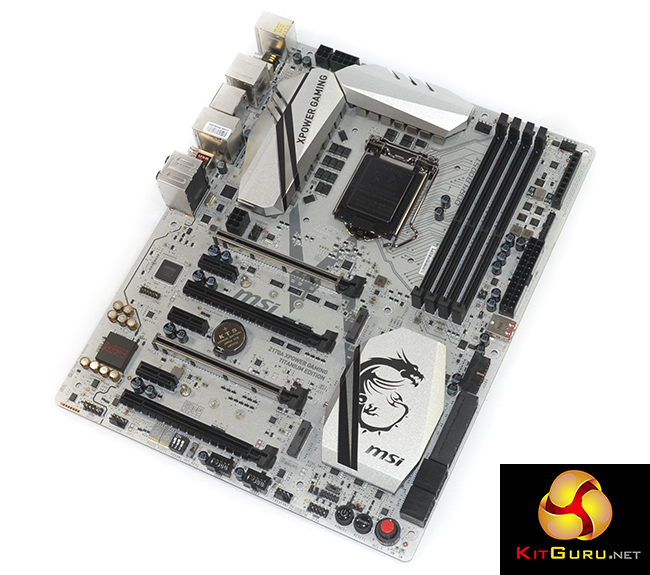The bold gamble has paid off because the MSI Z170A XPower Gaming Titanium Edition is a unique board in many respects and it delivers comprehensively from a performance perspective.
Performance from the board is good. There is nothing to suggest that MSI's offering is any slower or faster than alternative Z170 solutions, and that's what we expect from modern Intel-based motherboards.
Overclocking results were positive, however the process of obtaining them was far from straightforward. I do not like MSI's method of controlling the core voltage levels that one applies and it takes a needless amount of testing in order to find a stable voltage around the level that is actually desired. MSI needs to update the board's voltage control methods so that when a user sets a 1.4V core voltage, the chip receives 1.4V, not up to 1.44V.
MSI's expansion options are extensive and the allocation of chipset-fed storage lanes is smart. Some benchmarkers may be disappointed to see that support for three graphics cards with x8 connections is given up in favour of extra features (USB 3.0, M.2 x4, USB 3.1) from the chipset's PCIe 3.0 lanes.
MSI's Click BIOS 5 UEFI is very good. The implementation is stable and is easier to use than many of the company's previous iterations. The OS-based software package is also strong, with a good variety of software being provided for gaming and general usage scenarios.
While MSI has done many of the more minor things well, such as deploying a BIOS Flashback implementation, bundling the useful OC Dashboard, and clearing the CPU area, there are also some questions to be raised. In some respects, the board seems to be stuck in a middle ground between targeting overclocking users and enthusiasts or gamers.
The board has many overclocking-geared features that will appeal to benchmarking fans, but instead of a third PCIe 3.0 x8 link from the chipset, sizeable chunks of budget are allocated to the audio solution and USB 3.1 ports. Conversely, enthusiasts and gamers will be pleased to see multiple M.2 slots, plenty of USB connectivity, and the dedicated headphone op-amps but will be disappointed by the omitted USB 3.1 Type-C connector.
With that said, an enthusiast gamer who also likes to dabble in overclocking from time-to-time is likely to be pleased by the board's multiple angles towards its feature set. There will be compromise for pure gamers and perhaps some for pure overclockers, but to the vast majority of people who fall somewhere in between, MSI's Z170A XPower Gaming Titanium Edition is going to be a compelling option.
Priced at £229.99 from OverclockersUK, MSI's Z170A XPower Gaming Titanium Edition motherboard sits towards the upper end of Z170 pricing. Strong performance and a healthy feature set make MSI's board a worthy purchase and the unique styling may fit your build in such a way that MSI's Z170A XPower Gaming Titanium Edition becomes the go-to choice of motherboard for you.
Discuss on our Facebook page, over HERE.
Pros:
- Unique approach to motherboard styling and component selection.
- Diverse set of features.
- Good overclocking tools – OC Dashboard, V-Check points, dual BIOS chips, PCIe disabling switches.
- Strong power delivery system with good overclocking capacity.
- Plenty of storage options.
- In-depth, easy-to-navigate UEFI implementation.
- Excellent OS software suite.
Cons:
- No USB 3.1 Type-C ports.
- Some overclocking settings are not as straightforward as they could be.
- The appearance of an IO port cover may be missed by some people.
KitGuru says: MSI deserves credit for trying something new with the Z170A XPower Gaming Titanium Edition, and the gamble results in a board with strong performance and an extensive feature set.
 KitGuru KitGuru.net – Tech News | Hardware News | Hardware Reviews | IOS | Mobile | Gaming | Graphics Cards
KitGuru KitGuru.net – Tech News | Hardware News | Hardware Reviews | IOS | Mobile | Gaming | Graphics Cards






Allow me to show ~you a genuine way to earn a lot of extra money by finishing basic tasks from your house for few short hours a day — See more info by visiting >MY*&___(DISQUS)*%___ID)
I think you should do some reading before using harsh terms such as “stupid advertising”, perhaps you might even learn something new 😉
https://en.wikipedia.org/wiki/USB#USB_3.1
” The USB 3.1 standard increases the data signaling rate to 10 Gbit/s in the USB 3.1 Gen2 mode, double that of USB 3.0 (referred to as USB 3.1 Gen1)”
The information in that article, the referenced technical documents for which I have examined many times over the past year, says what I have said in the article. ‘USB 3.1 Gen 2’ is 10Gbps. USB 3.0 is 5Gbps and is sometimes referred to as ‘USB 3.1 Gen 1’ (by many vendors, not just MSI, as I clearly pointed out in the article).
5Gbps USB had always been referred to as USB 3.0 (pretty much universally, as far as I can tell) before USB 3.1 entered the consumer limelight. Now that USB 3.1 ports at up to 10Gbps are available, marketing teams are quickly changing the naming structures of their 5Gbps USB 3.0 ports. Even Intel refers to the 5Gbps ports as USB 3.0 connections in their very own chipset diagrams.
I fail to see what there is to learn from the Wikipedia page that I hadn’t already written in the article.
Luke
Sadly, you fail to see quite a lot.
Please expand as I want to make sure that the information is correct and clear.
I wrote what I wrote as there is currently a lot of confusion surrounding the USB interface due to its new forms and speeds. Many consumers do not realise that USB 3.1 *Gen 1* is just another name for the 5Gbps USB 3.0 connection and therefore may make an uninformed purchasing decision thinking that it is actually the 10Gbps USB 3.1 *Gen 2* port being referred to.
Thanks,
Luke
No, what you wrote was “stupid advertising”, implying that it’s fake and wrong, when in fact you were wrong and did not do your homework.
So, in fact, it’s not stupid advertising at all and it’s just the way that the USB Implementers Forum now ALSO refers to the USB 3.0 interface, making it quite official and NOT stupid advertising at all.
The only confusing things are in fact those you wrote and you seem to be the only one confused, but what’s even worse is that you do not willing to admit it and keep thinking you are not wrong.
Anyway, believe whatever you wish and misinform you readers any way you like or can.
audio 115bB… what’s it??
OK we’ll just have to agree to disagree. Intel sells the chipset with USB 3.0 ports (no reference to USB 3.1 Gen 1 – which is the same as USB 3.0 but a different name, as I clearly wrote in the article). If Intel, the chipset provider, sells them as USB 3.0 ports then there is very little reason to change that naming scheme and advertising/marketing would be one of the few reasons to do so. So the word ‘stupid’ in this case points out how there is no need to change the naming scheme of ports that derive from Intel’s Z170 chipset. The word ‘stupid’ doesn’t always need to imply ‘fake or wrong’ as you imply. Those two words are not fact anyway – as is clear by now, they are debatable and the information supplied afterwards is factually correct.
You keep referring to the information as ‘wrong’ when it isn’t. If you read the rest of the sentence and paragraph instead of focussing on two (clearly debatable) words out of over 6000 in the article then you will see what is written is correct, both in terms of naming and speeds. Is USB 3.1 Gen 2 rated at 10Gbps, as written? Yes. Is USB 3.1 Gen 1 the same as USB 3.0 and rated at 5Gbps, as written? Yes. Both of those pieces of information are correct, and not ‘wrong’ as you refer to them.
Anyway, this debate is going nowhere. I have pointed out to readers who know less about the new USB standards that USB 3.1 Gen 1 ports are the same as USB 3.0 5Gbps ports, not the newer USB 3.1 Gen 2 10Gbps ports. It’s clear and there is absolutely no misinformation so now readers can understand how to compare the number of USB 3.1 Gen 1 ports on this board against the number of USB 3.0 ports on other vendors’ boards.
The audio system is based around the Realtek ALC 1150 codec.
Why not dB? Box had the wrong, this is false advertising? Quality is very bad.
MSI’s Audio Boost 3 system uses the Realtek ALC 1150 audio codec which is rated at a SNR of 115dB.
I just have to say… Luke is definitely right. I’m not a member on this site, but I just had to link my google+ so that I could comment on this.
I was hoping to get some feedback from people who bought this board. Instead it’s the standard nerd-fight-fest I should have expected. How sad. Anyway, this is a cool and unique looking motherboard with tons of features that I will never possibly need. I only wish it was $100 less